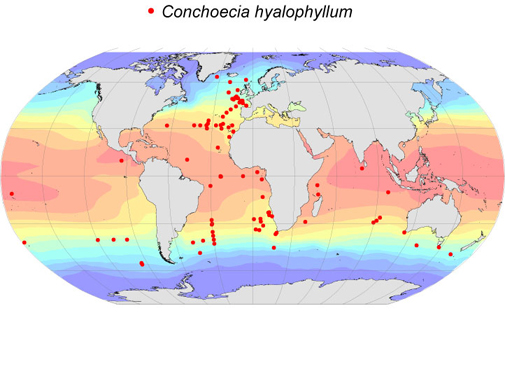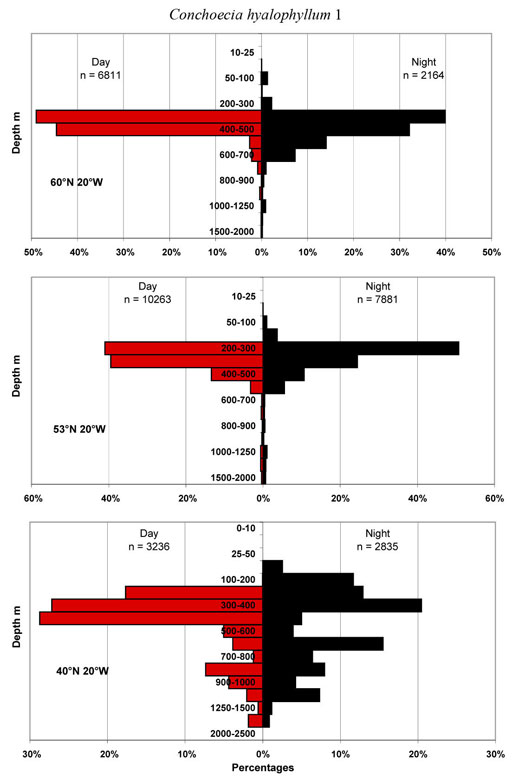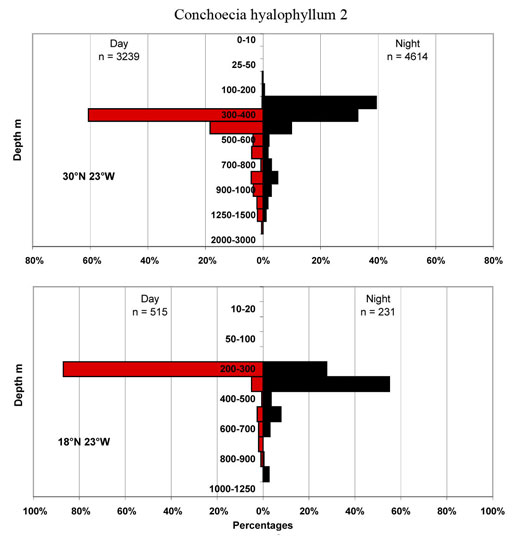Atlas of Atlantic Ostracods
Taxon details
Conchoecia hyalophyllum Claus, 1890
- Order:
- MYODOCOPA
- Suborder:
- Halocypridina
- Family:
- Halocyprididae
- Subfamily:
- Conchoecinae
- Size range (females):
- 1.5-1.9 mm
- Size range (males):
- 1.4-1.7 mm
- Depth:
- epi-/mesopelagic
Notes
451 records
This species was originally described from the northeast Atlantic near the Canary Islands and Madeira. Müller (1906) included it in his “Magna group” of species, which Poulsen (1973) retained as Conchoecia. Skogsberg (1930) described a very similar species tetragona and it is generally assumed that this species is synonymous (Angel, 1970). However, knowing how thorough most of Skogsberg’s observations were, it is possible that there are cryptic species within the present species concept. It predominantly occurs in temperate waters and is advected into higher latitudes particularly in summer months. In the Southern Ocean it has infrequently been reported from south of the Subtropical Front. Similarly, in the North Atlantic it has been found in small numbers as far north as 60°N. The early juvenile stages occur at shallow mesopelagic depths and do not undergo diel vertical migrations. The adults live at somewhat deeper than the juveniles during the day and undertake diel vertical migrations up to the base of the seasonal thermocline at night. Occasionally they move up into the wind-mixed layer and specimens have occasionally been caught in the neuston. Living specimens are translucent with faint touches of yellow and orange-red pigment associated with the bases of the limbs.
| 44°N | N | Mean mm | s.d. | Range mm |
|---|---|---|---|---|
| Females | 91 | 1.66 | 0.076 | 1.50-1.86 |
| Males | 126 | 1.58 | 0.045 | 1.44-1.66 |
| A-1 | 555 | 1.17 | 0.047 | 1.04-1.28 |
| A-2 | 1260 | 0.79 | 0.028 | 0.70-0.86 |
| A-3 | 650 | 0.57 | 0.019 | 0.52-0.62 |
| Equator | n | Mean mm | s.d. | Range mm |
|---|---|---|---|---|
| Females | 15 | 1.66 | 0.039 | 1.50-1.86 |
| Males | 10 | 1.59 | 0.027 | 1.44-1.66 |
| A-1 | 47 | 1.17 | 0.031 | 1.04-1.28 |
| A-2 | 6 | 0.78 | 0.031 | 0.70-0.86 |
| A-3 | 8 | 0.60 | 0.013 | 0.58-0.62 |






